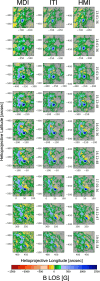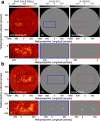A deep learning framework for instrument-to-instrument translation of solar observation data
- PMID: 40175360
- PMCID: PMC11965394
- DOI: 10.1038/s41467-025-58391-4
A deep learning framework for instrument-to-instrument translation of solar observation data
Abstract
The constant improvement of astronomical instrumentation provides the foundation for scientific discoveries. In general, these improvements have only implications forward in time, while previous observations do not benefit from this trend, and the joint use of data sets from different instruments is typically limited by differences in calibration and quality. We provide a deep learning framework for Instrument-To-Instrument translation of solar observation data, enabling homogenized data series of multi-instrument data sets. This is achieved by unpaired domain translations with Generative Adversarial Networks, which eliminate the need for spatial or temporal overlap to relate instruments. We demonstrate that the available data sets can directly profit from instrumental improvements, by applying our method to four different applications of ground- and space-based solar observations. We obtain a homogenized data series of 24 years of space-based observations of the solar EUV corona and line-of-sight magnetic field, solar full-disk observations with increased spatial resolution, real-time mitigation of atmospheric degradations in ground-based observations, and unsigned magnetic field estimates from the solar far-side based on EUV imagery. The direct comparison to simultaneous high-quality observations shows that our method produces images that are perceptually similar, and enables more homogeneous multi-instrument data sets without the requirement of spatial or temporal alignment.
© 2025. The Author(s).
Conflict of interest statement
Competing interests: The authors declare no competing interests.
Figures








Similar articles
-
A Statistical Comparison of EUV Brightenings Observed by SO/EUI with Simulated Brightenings in Nonpotential Simulations.Sol Phys. 2022;297(10):141. doi: 10.1007/s11207-022-02074-6. Epub 2022 Oct 26. Sol Phys. 2022. PMID: 36310545 Free PMC article.
-
Solar X-ray and EUV imager on board the FY-3E satellite.Light Sci Appl. 2022 Nov 22;11(1):329. doi: 10.1038/s41377-022-01023-z. Light Sci Appl. 2022. PMID: 36414615 Free PMC article.
-
On the Performance of Multi-Instrument Solar Flare Observations During Solar Cycle 24.Sol Phys. 2018;293(2):18. doi: 10.1007/s11207-017-1233-x. Epub 2018 Jan 17. Sol Phys. 2018. PMID: 31258200 Free PMC article.
-
Solar Adaptive Optics.Living Rev Sol Phys. 2011;8:2. doi: 10.12942/lrsp-2011-2. Epub 2011 Jun 10. Living Rev Sol Phys. 2011. PMID: 27194964 Free PMC article. Review.
-
Recent Advances in Deep Learning-Based Spatiotemporal Fusion Methods for Remote Sensing Images.Sensors (Basel). 2025 Feb 12;25(4):1093. doi: 10.3390/s25041093. Sensors (Basel). 2025. PMID: 40006322 Free PMC article. Review.
References
-
- Jungbluth, A. et al. Single-frame super-resolution of solar magnetograms: investigating physics-based metrics \& losses. Preprint at arXiv10.48550/arXiv.1911.01490 (2019).
-
- Hamada, A., Asikainen, T. & Mursula, K. New homogeneous dataset of solar EUV synoptic maps from SOHO/EIT and SDO/AIA. Sol. Phys.295, 1–20 (2020).
-
- Hamada, A., Asikainen, T. & Mursula, K. A uniform series of low-latitude coronal holes in 1973-2018. Sol. Phys.296, 40 (2021).
-
- Goodfellow, I., Bengio, Y. & Courville, A. Deep Learning (MIT Press, 2016).
-
- Ramos, A. A., de la Cruz Rodríguez, J. & Yabar, A. P. Real-time, multiframe, blind deconvolution of solar images. Astron. Astrophys.620, A73 (2018).
Grants and funding
LinkOut - more resources
Full Text Sources

